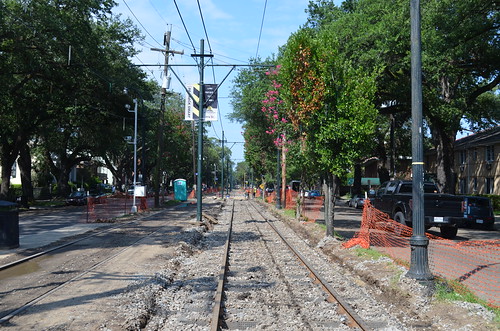
Rail tie work is still ongoing on the St. Charles Avenue streetcar line. The work was briefly suspended and streetcar service temporarily reinstated for the benefit of visitors over the Fourth of July/Essence Fest weekend.
Major T-P feature this morning based on the release of a report by the advocacy group Ride New Orleans on the state of our public transit.
The news is bad.
The report argues that the RTA has not kept pace with the city's repopulation after Katrina: The agency restored only 36 percent of its bus and street car services while more than 86 percent of the city's population has returned, the report said. And ridership for public transit has increased every year by roughly 20 percent, although it remains a mere fraction of the service's pre-Katrina numbers.For all the talk you see bandied about hyping the busy, growing, fantabulous "New New Orleans," these numbers show the old New Orleans sure did move a lot more people around.
"We did find that the current transit system is inequitable. We found that a lot of the service decreases have been in low-income communities and in communities of color," said Ride New Orleans president Trevor Theunissen.
But in 2012, Veolia only operated 79 of the RTA's 86 buses during peak times, a much smaller fleet than the 301 buses that cruised city streets at rush hour in 2004, Ride New Orleans found. Augustine said the fleet is now closer to 136 buses, but remains a far cry from its pre-Katrina ranks.But these concepts, "booming New New Orleans" and fewer public transit riders aren't as contradictory as they sound. Remember, the city we've rebuilt is no longer interested in serving poor people. We just watched a movie this week where Pres Kabacoff told us the poors were "a drag."
The RTA also eliminated at least 33 routes after the storm, including 10 express bus lines that shot riders across town with few stops in between, Ride found. The agency also did away with all "school trippers," public buses that augmented school bus service. Several major routes were stretched to cover extra miles where others never returned, such as those on Carrollton and Mirabeau avenues, Almonaster Boulevard and Desire Street.
Instead, the future of public transit will be in attracting "choice riders."
Even as ridership increases, the system needs to attract car owners -- riders who choose to use public transit -- rather than relying on passengers without other options, said Renne, the UNO transportation expert. In most cities, he said, the number of people who have no vehicles and must use public transit is too small to build a viable system.That way you can run fewer buses for fewer riders who don't mind paying a higher fare. Revenue per rider goes up, costs go down. Oh, and yes, of course fares are going up.
"You've got to attract choice riders. This is not rocket science. These are simple things," Renne said.
The Ride New Orleans report comes as Veolia has signaled it may pursue a rate increase as a partial fix to a potential $10 million shortfall in 2015. At the same time, Veolia has proposed a $5 million-a-year expansion of its routes and bus services.RTA also recently took over operation of the Mississippi River ferries. Pedestrians who once crossed the river for free now pay two dollars each direction. But probably they are "choice riders" so it's ok.
No comments:
Post a Comment